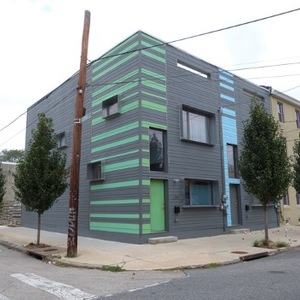
In this post, I’ll share the first of two concept houses showing examples of how to incorporate low-carbon building strategies. While somewhat more complicated and more expensive than code-minimum assemblies, they provide much better comfort and energy savings. They also allow for smaller heating and cooling systems without much increase in embodied carbon or changes to conventional practices.
Foundation
Concrete has high embodied carbon, but a slab on grade with sealed concrete as the finished floor is usually the least expensive approach, and up to 50% of the carbon-polluting Portland cement can be replaced with Portland-reducing SCMs (supplementary cementitious materials), such as pozzolans.
With most slab-on-grade homes that have insulation under the slab, the insulation is located directly below the concrete, but this makes it hard to do a good job with the insulation, and there should be insulation below the turned-down footing anyway. A simple approach is to grade and compact crushed stone, then form the perimeter with foam, add a layer of foam, and top with compactible fill. I spec borate-treated EPS insulation for use below grade; recycled XPS is another option. Don’t use polyiso because it absorbs too much water, and don’t use new XPS because the energy savings will never make up for the climate impact of its manufacturing process compared to using EPS. Expanded glass aggregate is another option.
For the form edges, consider WarmFörm by ByggHouse. Compact the fill in 6-in. lifts, cover with a heavy-duty vapor retarder, add reinforcing steel where necessary, use a concrete mix with microfibers to reduce fine cracking, and allow the mix to damp-cure slowly to improve the strength—most concrete needs to be kept damp for a week to reach 90% of its design strength. In cold climates, consider adding a frost wing even if it’s not…
Weekly Newsletter
Get building science and energy efficiency advice, plus special offers, in your inbox.

This article is only available to GBA Prime Members
Sign up for a free trial and get instant access to this article as well as GBA’s complete library of premium articles and construction details.
Start Free TrialAlready a member? Log in














21 Comments
Great post as always, though since this specifically noted as being a low carbon design it would be great to have a BEAM, or other quantifiable metrics included. Presumably a past project of Michael's could be used to standardize things between posts, then people could get an apples to apples comparison.
Thanks, and good points. I don't have the time to do a full carbon accounting analysis but if someone else wants to I would welcome it. The purpose of this post is to show some simple approaches to lower-carbon assemblies than typical details. There are a lot of variables to consider.
Is there any fear of condensation on plywood baffles, as they are continuous? Or is there perm and air leakage high enough to make it a non issue?
Plywood is responsive to moisture; at 1/2" thick it's about 10 perms when damp (https://buildingscience.com/documents/information-sheets/info-312-vapor-permeance-some-materials) so at 1/4" it should be fully vapor-open.
Makes sense, I am a little curious if there is any data looking at it but it does seem pretty safe. A bit of added safety could also be achieved via a high perm membrane at the ridge.
freyr_design,
Here is Martins take on the topic of permeable/impermeable baffles :
https://www.greenbuildingadvisor.com/article/site-built-ventilation-baffles-for-roofs?oly_enc_id=7565D0080934G5L
This is interesting and begs the question, could you just use a high perm roof underlayment like pro clima adhero (or even felt as per that table from BSC it is around 30) use battens on top and not worry about any insulation ratios? or is there so much vapor drive through the rafters in the above assembly that it would not work without this?
Response to #13: I have over-vented one roof, using taped Zip sheathing diagonal 2x furring and standing-seam metal roofing. Is that what you're proposing?
Ya that’s essentially what I was getting at, it’s technically not an assembly “known to work” but it is performing well? Your build up is dense pack directly under zip with over vent and metal roofing?
Reply to #18: yes, coincidentally I was there yesterday and it seems to be performing fine after 7-ish years. It's a conditioned attic of a 2.5 story home in Maine, with 5/8" taped Zip sheathing above and 7/16" taped Zip sheathing below gusseted rafters, dense-packed with cellulose to R-60. It wasn't my first choice of an assembly but the budget was super tight and it seemed like it should work. We included data loggers; they showed some moisture accumulation in late winter, as expected, but nothing to worry about with borate-treated cellulose, before the data loggers unfortunately failed.
Lessons learned: best for a dead-simple roof. Dealing with valleys and diagonal furring was complicated. There will be condensation from night sky radiation; I'm a fan of Zip but in retrospect I would have added a secondary WRB.
I am excited to try 'The Perfect Block" system soon to reduce concrete, basement insulation and hopefully labor as well.
It looks like a good product: https://www.theperfectblock.com/. I can't find any R-values listed on their website or in their technical manuals, though; have you found any?
Edit to add: they just emailed me, R-32 for their 10" block and R-24 for their 8" block. Plus some baloney about R-values not being a good metric for efficiency. But those are decent values, considering the foam has cementitious additives that also make them UV resistant.
Michael,
https://www.greenbuildingadvisor.com/article/the-perfect-block-foundation
Haha, I thought I remembered Ben Bogie having experience with them but I didn't find anything in my email. This is why. Plus he talked about it on a BS+Beer show around the same time. Thank you.
Michael,
From watching the BS + Beer shows I think of you guys as being in the same room quite often - which of course isn't the case.
Nope, I haven't seen Ben in person since last November. Same for Emily, in fact, though we only live an hour apart.
It’s nice to see recycled EPS being used. In my northern MA town, we send it to the landfill.
That's too bad. Many of my clients and contractors get recycled foam from the Insulation Depot in Framingham, MA, practically in your back yard.
I've found reusable EPS boards on Facebook Marketplace. Always worth looking for a reuse option.
Why not use a "slabless" slab system?
https://www.greenbuildingadvisor.com/article/concrete-free-slab
Haha, as far as I know, I was the first to design that type of system: https://www.greenbuildingadvisor.com/article/minimizing-concrete-in-a-slab-on-grade-home. I think it's a good approach but it's not the simplest or cheapest, and not all code officials or structural engineers will accept them. The lowest-cost floor is an unpolished concrete slab.
Log in or become a member to post a comment.
Sign up Log in